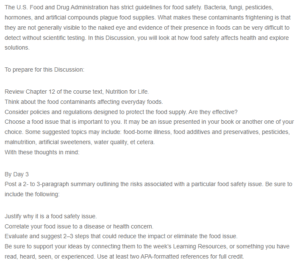Food Safety Issues
Food safety issues such as adulteration are acute or chronic issues that are hazardous and alter food in a manner that injures consumers’ health (Lam & Patel, 2022). Food adulteration involves deliberately decreasing food quality by adding inferior substances, removing important substances, or substituting essential substances. Adulteration is a business strategy to increase profits and decrease production costs. Some companies practice food adulteration to imitate food products from competitor companies. Adulteration can be done to increase production quantity and, in extension, improve sales.
Adulteration is a food safety issue since it leads to diseases and harmful effects on consumers. Adulterants cause conditions such as stomach disorders, cancer, liver disorders, heart disease, musculoskeletal disorders, and food poisoning (Kene & On, 2020). The experienced harmful effects depend on the adulterant. Stomach disorders are caused by adulterants such as starch powder, water, lead chromate, dyes, urea, washing soda, and chalk dust. Liver disorders are caused by adulterants such as weed seeds, straws, damaged grains, artificial coloring agents, and cassia bark. Artificial dyes such as metanil yellow are carcinogenic and cause different types of cancer. Cassia bark is an adulterant used in cinnamon sticks that causes mouth sores, low blood glucose levels, and liver damage.
The harmful effects of adulteration occur globally, making eliminating food adulteration a public health priority. Adulteration can be prevented through laws and policies that outline food adulteration by companies as a punishable offense (Lam & Patel, 2022). Consumers are educated on the importance of checking for the food-validated label, manufacturing date, expiry date, ingredients, and license number before buying a food product. Consumers should check canned foods for leakages. Lastly, production companies must take necessary safety measures during food processing, packaging, transportation, and warehousing (He et al., 2021).
References
He, Y., Bai, X., Xiao, Q., Liu, F., Zhou, L., & Zhang, C. (2021). Detection of adulteration in food based on nondestructive analysis techniques: a review. Critical reviews in food science and nutrition, 61(14), 2351–2371. https://doi.org/10.1080/10408398.2020.1777526.
Kene Ejeahalaka, K., & On, S. (2020). Effective detection and quantification of chemical adulterants in model fat-filled milk powders using NIRS and hierarchical modeling strategies. Food Chemistry, 309, 125785. https://doi.org/10.1016/j.foodchem.2019.125785
Lam C, Patel P. Food, Drug, and Cosmetic Act. [Updated 2022 Aug 4]. In: StatPearls [Internet]. Treasure Island (FL): StatPearls Publishing; 2022 Jan-. Available from: https://www.ncbi.nlm.nih.gov/books/NBK585046/.
ORDER A PLAGIARISM-FREE PAPER HERE
We’ll write everything from scratch
Question
The U.S. Food and Drug Administration has strict guidelines for food safety. Bacteria, fungi, pesticides, hormones, and artificial compounds plague food supplies. What makes these contaminants frightening is that they are not generally visible to the naked eye and evidence of their presence in foods can be very difficult to detect without scientific testing. In this Discussion, you will look at how food safety affects health and explore solutions.

Food Safety Issues
To prepare for this Discussion:
Review Chapter 12 of the course text, Nutrition for Life.
Think about the food contaminants affecting everyday foods.
Consider policies and regulations designed to protect the food supply. Are they effective?
Choose a food issue that is important to you. It may be an issue presented in your book or another one of your choice. Some suggested topics may include: food-borne illness, food additives and preservatives, pesticides, malnutrition, artificial sweeteners, water quality, et cetera.
With these thoughts in mind:
By Day 3
Post a 2- to 3-paragraph summary outlining the risks associated with a particular food safety issue. Be sure to include the following:
Justify why it is a food safety issue.
Correlate your food issue to a disease or health concern.
Evaluate and suggest 2–3 steps that could reduce the impact or eliminate the food issue.
Be sure to support your ideas by connecting them to the week’s Learning Resources, or something you have read, heard, seen, or experienced. Use at least two APA-formatted references for full credit.

